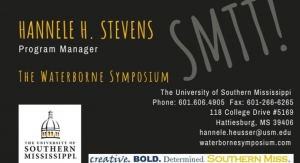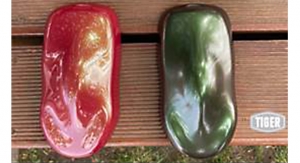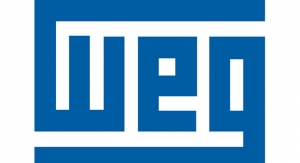Kerry Pianoforte, Editor12.18.15
Valued for its lower environmental impact, powder coatings are used in a wide variety of applications. According to Chemark Consulting Group, the global powder coatings market can be divided into four segmentations by substrate: metal, wood, glass and plastics. Metal substrates because of its natural conductivity and heat tolerance comprise 93 percent of the value, wood and plastic substrate are three percent and plastics is one percent.
Chemark Consulting reported that there are several segments that offer growth potential for powder coatings: “The transportation market segment has always considered powder coatings an economical alternative for primarily vehicle body parts where abuse and corrosion potential exists. Underbody and under hood, tail pipe extensions, windshield wiper devices and wheel rims are such examples. Full scale widespread commercial topcoats…has eluded powder coatings. However, powder coatings used as a primer coat over ecoat, has been accepted.
The global powder coatings market is expected to reach $12.48 billion by 2020, according to a new study by Grand View Research, Inc. Growing support for the use of powder coatings in comparison to conventional liquid paints by regulatory agencies such as EPA and REACH on account of negligible VOC emissions is expected to be a key driver for market growth. In addition, growing application demand with regards to automotive, appliances and consumer goods is also expected to drive powder coating sales over the next six years.
According to Grand View Research, consumer goods are the largest application market for powder coatings, with estimated consumption of 437.3 kilo tons in 2013. Automotive and general industries were the key application markets, with combined powder coating sales expected to reach $5.11 billion by 2020. Powder coating demand in furniture was relatively small in 2013 but is expected to witness substantial growth of more than 7.6 percent percent from 2014 to 2020.
“We’re seeing the continuation of tighter environmental regulations targeted at traditional solvent-based coatings, which are driving market preference for powder. Powder coatings offer strong performance, minimal environmental impact and in many cases, lower cost,” said Shelley Verdun, PPG product manager, Powder Coatings. “The trend is global. In China, the extrusions market is shifting from PVDF liquid to powder for projects and the Chinese government recently imposed a sales tax on liquid coatings that don’t achieve a minimum VOC threshold, which also is driving the switch to powder.”
“In Europe and Latin America, powder is continuing to gain position on liquid, and we’re seeing a shift from liquid to powder in the wood coatings/MDF segment as well,” Verdun continued. “In Latin America, the move toward powder isn’t being driven as much by government legislation as it is by new global manufacturing specs for low-VOC coatings.”
“Since powder coatings are VOC free, they have certainly benefited from stricter environmental regulations and so demand has historically outpaced the overall growth in coatings demand,” said Mark Reekie, marketing manager/North Europe for AkzoNobel’s Powder Coatings business. “However, it is important to point out that customers are only willing to switch from liquid to powder systems when we can also show that there is also an economic and performance advantage in doing so.”
Environmental regulations continue to impose stricter rules around VOC emissions as well as waste disposal. “Powder coatings continue to be a strong option for the right substrate to meet the regulatory and customer needs,” said Meghan Hodge, global product marketing manager – Functional Coatings at Axalta Coating Systems.
2015 was a good year for the powder coatings market.
Overall, PPG saw continued demand for powder in 2015 globally and expects that trend to continue into 2016 and beyond. “It is being pushed in large part by government legislation, but also by other factors such as cost, ease-of-application, higher utilization rates, and other processing and performance benefits,” said Verdun. “Powder application equipment advances have also contributed to the growth of powder coatings. Powder utilization rates of 90 percent or higher are common, compared to 30-80 percent utilization rates for most other spray coating processes.”
“The powder coatings market continues to grow at above-GDP levels,” said Reekie. “Asia Pacific and in particular China continue to grow, but not at the levels seen earlier in the decade as a result of China’s market slowdown. Growth in Europe was quite varied due to the differing economic fortunes across the region.”
PPG sees demand and growth in general industrial markets for powder, as well as in metal office furniture, appliance, automotive parts and aluminum extrusion markets. “By region, the number one market is China, where GDP continues to grow,” Verdun explained. “Germany, Central and Eastern Europe, the Middle East and Africa also are growth markets. In the other EMEA (Europe, Middle East and Africa) countries, increased environmental regulation will continue to drive powder growth versus liquid coatings.”
Geographically, China, Southeast Asia India and South America are still regions with a lot of opportunity despite some of the short-term economic problems. “In terms of markets, there is still a lot of opportunity to expand in the building and construction sector, and particularly in the automotive sector, where the penetration of powder coatings is still relatively low,” said Reekie.
Powder coatings manufacturers are meeting the demands of its customers who are continuing to push for extended durability, lower VOC emissions, faster cure rates, lower cure temperatures, thinner films, improved appearance, improved metallic color space and other developments such as compact process systems that remove cost and complication from coatings application processes. “We’re also seeing a trend towards developing powder coatings for non-metal substrates as well as powder coatings with increased functionality, such as the ability to self-clean, impart anti-microbial properties and increase light reflectivity,” said Verdun.
PPG Industries’ most recent breakthrough in powder is an exclusive cross-link polymer technology that it introduced with ENVIROCRON HTE coatings, a new product that improves transfer-efficiency rates for difficult-to-coat applications and surfaces.
“In addition, we have expanded our metallic and metal effect capabilities in powder, particularly for the metal office furniture and architectural aluminum extrusion markets,” Verdun said. “In Brazil, we introduced a low-cure coating for the appliance industry as well as a highly flexible coil-springs coating that features improved corrosion resistance and cures quickly at lower temperatures to reduce energy use and VOC emissions.”
AkzoNobel recently launched Interpon Cr, Interpon ReFlex, and Interpon Align.
Interpon Cr is a bright metallic powder coating that provides a sustainable and cost-effective alternative to chrome plating. It combines a chrome-like finish with the proven performance of a two-coat powder coating for applications such as furniture, lighting and other interior fixtures.
Interpon ReFlex is an ultra-reflective powder coating which can increase the effective output of commercial lighting fixtures by up to 30 percent thanks to its high levels of light reflectance. This allows makers of lighting fixtures to obtain more light from a specified power input for any light source.
Interpon Align is an innovative innovative two-coat, one-bake powder coating system using dry-on-dry powder technology. This offers customers significant productivity and energy efficiency improvements by eliminating a cure cycle, and can also result in lower capital investment.
The broad industrial market that powder products serves presents many opportunities. “It encompasses many products that don’t even have a defined market segment such as fire extinguishers, metal cabinets, iPad stands, and the like,” said Hodge.
“However, our ever-expanding Alesta product line offers coatings suited for just about any metal substrate that needs to be coated.”
“For example, Alesta AR powder coatings are an extremely viable solution to traditional paint for architecture design professionals with the added benefit that they are environmentally responsible due to emitting virtually no VOCs or targeted hazardous air pollutants,” she added. “They are also cost-effective and have excellent weatherability. Alesta AR products meet the rigorous requirements of AAMA 2603, AAMA 2604, and AAMA 2605. They are ideal for hand railings, fencing, aluminum extrusions, door and window frames and can also be used on wheels and motorcycle parts.”
Recently, Axalta has launched architectural anodic look powders and high-performing FBE coatings for oil and gas pipelines. These Architectural Global Colors and anodic colors are for design professionals or any other individual that needs a high level of weatherability and excellent abrasion resistance.
Axalta Coating Systems has opened a first-of-its kind dual Refinish and Powder Coatings Learning and Development Center in Houston, Texas. The Center, built adjacent to Axalta’s powder coatings manufacturing plant, serves Axalta’s collision repair and commercial coatings customers by providing the latest learning and development programs designed to improve technician and business performance. The Learning and Development Center is expected to attract thousands of collision repair professionals to the Houston area for multi-day classes that provide students with classroom education and hands-on experience. The center features three classrooms equipped with technology for distance learning, innovative seating pods to support collaboration, two paint mixing stations, two spray booths, and space for the build-out of the powder coatings training program in 2016. Classes will be available in both English and Spanish.
“We are proud to offer a centrally-located, multi-lingual training facility to serve customers in the South,” remarked Jeff Blake, Axalta Business Director. “The investment in this high-tech facility reinforces our commitment to help our customers continue education through in-person technical training and eLearning programs that are hosted here in Houston and can be broadcast to customers throughout North America,” Blake added. “Axalta’s commitment to the improvement and economic well-being of the local industrial economy through its Houston Refinish and Powder Coatings Learning and Development Center is a genuine asset to this city,” as stated in a proclamation from Houston Mayor Annise Parker’s office.
The Learning and Development Center opened with a celebratory program that featured Ray Evernham, three-time NASCAR champion crew chief and TV host, Houston Rockets cheerleaders, and a special scholarship and grant presentation to students attending Universal Technical Institute (UTI) collision repair program. The event culminated in a ceremonial ribbon cutting by Blake, Evernham, Nigel Budden-Axalta Vice President, and Jeannie Bollinger-Houston West Chamber of Commerce President. Axalta customers, partners, and employees enjoyed the program that was followed by tours, photos with the No. 24 Axalta Chevrolet SS NASCAR racecar, spray paint sessions and more.
“Thanks to the generous support of Axalta Coating Systems, the UTI Foundation is able to help the next generation of collision repair professionals as they pursue their dreams,” said Jennifer Maher, UTI Foundation Vice President and Executive Director. “The UTI Foundation’s Axalta Collision Repair Awards help deserving collision repair program students to achieve their educational goals. The award helps the recipient with tuition support or assists with an unexpected emergency that threatens their ability to stay in school. We are grateful to have the support of such a wonderful industry leader as Axalta!”
Chemark Consulting reported that there are several segments that offer growth potential for powder coatings: “The transportation market segment has always considered powder coatings an economical alternative for primarily vehicle body parts where abuse and corrosion potential exists. Underbody and under hood, tail pipe extensions, windshield wiper devices and wheel rims are such examples. Full scale widespread commercial topcoats…has eluded powder coatings. However, powder coatings used as a primer coat over ecoat, has been accepted.
The global powder coatings market is expected to reach $12.48 billion by 2020, according to a new study by Grand View Research, Inc. Growing support for the use of powder coatings in comparison to conventional liquid paints by regulatory agencies such as EPA and REACH on account of negligible VOC emissions is expected to be a key driver for market growth. In addition, growing application demand with regards to automotive, appliances and consumer goods is also expected to drive powder coating sales over the next six years.
According to Grand View Research, consumer goods are the largest application market for powder coatings, with estimated consumption of 437.3 kilo tons in 2013. Automotive and general industries were the key application markets, with combined powder coating sales expected to reach $5.11 billion by 2020. Powder coating demand in furniture was relatively small in 2013 but is expected to witness substantial growth of more than 7.6 percent percent from 2014 to 2020.
“We’re seeing the continuation of tighter environmental regulations targeted at traditional solvent-based coatings, which are driving market preference for powder. Powder coatings offer strong performance, minimal environmental impact and in many cases, lower cost,” said Shelley Verdun, PPG product manager, Powder Coatings. “The trend is global. In China, the extrusions market is shifting from PVDF liquid to powder for projects and the Chinese government recently imposed a sales tax on liquid coatings that don’t achieve a minimum VOC threshold, which also is driving the switch to powder.”
“In Europe and Latin America, powder is continuing to gain position on liquid, and we’re seeing a shift from liquid to powder in the wood coatings/MDF segment as well,” Verdun continued. “In Latin America, the move toward powder isn’t being driven as much by government legislation as it is by new global manufacturing specs for low-VOC coatings.”
“Since powder coatings are VOC free, they have certainly benefited from stricter environmental regulations and so demand has historically outpaced the overall growth in coatings demand,” said Mark Reekie, marketing manager/North Europe for AkzoNobel’s Powder Coatings business. “However, it is important to point out that customers are only willing to switch from liquid to powder systems when we can also show that there is also an economic and performance advantage in doing so.”
Environmental regulations continue to impose stricter rules around VOC emissions as well as waste disposal. “Powder coatings continue to be a strong option for the right substrate to meet the regulatory and customer needs,” said Meghan Hodge, global product marketing manager – Functional Coatings at Axalta Coating Systems.
2015 was a good year for the powder coatings market.
Overall, PPG saw continued demand for powder in 2015 globally and expects that trend to continue into 2016 and beyond. “It is being pushed in large part by government legislation, but also by other factors such as cost, ease-of-application, higher utilization rates, and other processing and performance benefits,” said Verdun. “Powder application equipment advances have also contributed to the growth of powder coatings. Powder utilization rates of 90 percent or higher are common, compared to 30-80 percent utilization rates for most other spray coating processes.”
“The powder coatings market continues to grow at above-GDP levels,” said Reekie. “Asia Pacific and in particular China continue to grow, but not at the levels seen earlier in the decade as a result of China’s market slowdown. Growth in Europe was quite varied due to the differing economic fortunes across the region.”
PPG sees demand and growth in general industrial markets for powder, as well as in metal office furniture, appliance, automotive parts and aluminum extrusion markets. “By region, the number one market is China, where GDP continues to grow,” Verdun explained. “Germany, Central and Eastern Europe, the Middle East and Africa also are growth markets. In the other EMEA (Europe, Middle East and Africa) countries, increased environmental regulation will continue to drive powder growth versus liquid coatings.”
Geographically, China, Southeast Asia India and South America are still regions with a lot of opportunity despite some of the short-term economic problems. “In terms of markets, there is still a lot of opportunity to expand in the building and construction sector, and particularly in the automotive sector, where the penetration of powder coatings is still relatively low,” said Reekie.
Powder coatings manufacturers are meeting the demands of its customers who are continuing to push for extended durability, lower VOC emissions, faster cure rates, lower cure temperatures, thinner films, improved appearance, improved metallic color space and other developments such as compact process systems that remove cost and complication from coatings application processes. “We’re also seeing a trend towards developing powder coatings for non-metal substrates as well as powder coatings with increased functionality, such as the ability to self-clean, impart anti-microbial properties and increase light reflectivity,” said Verdun.
PPG Industries’ most recent breakthrough in powder is an exclusive cross-link polymer technology that it introduced with ENVIROCRON HTE coatings, a new product that improves transfer-efficiency rates for difficult-to-coat applications and surfaces.
“In addition, we have expanded our metallic and metal effect capabilities in powder, particularly for the metal office furniture and architectural aluminum extrusion markets,” Verdun said. “In Brazil, we introduced a low-cure coating for the appliance industry as well as a highly flexible coil-springs coating that features improved corrosion resistance and cures quickly at lower temperatures to reduce energy use and VOC emissions.”
AkzoNobel recently launched Interpon Cr, Interpon ReFlex, and Interpon Align.
Interpon Cr is a bright metallic powder coating that provides a sustainable and cost-effective alternative to chrome plating. It combines a chrome-like finish with the proven performance of a two-coat powder coating for applications such as furniture, lighting and other interior fixtures.
Interpon ReFlex is an ultra-reflective powder coating which can increase the effective output of commercial lighting fixtures by up to 30 percent thanks to its high levels of light reflectance. This allows makers of lighting fixtures to obtain more light from a specified power input for any light source.
Interpon Align is an innovative innovative two-coat, one-bake powder coating system using dry-on-dry powder technology. This offers customers significant productivity and energy efficiency improvements by eliminating a cure cycle, and can also result in lower capital investment.
The broad industrial market that powder products serves presents many opportunities. “It encompasses many products that don’t even have a defined market segment such as fire extinguishers, metal cabinets, iPad stands, and the like,” said Hodge.
“However, our ever-expanding Alesta product line offers coatings suited for just about any metal substrate that needs to be coated.”
“For example, Alesta AR powder coatings are an extremely viable solution to traditional paint for architecture design professionals with the added benefit that they are environmentally responsible due to emitting virtually no VOCs or targeted hazardous air pollutants,” she added. “They are also cost-effective and have excellent weatherability. Alesta AR products meet the rigorous requirements of AAMA 2603, AAMA 2604, and AAMA 2605. They are ideal for hand railings, fencing, aluminum extrusions, door and window frames and can also be used on wheels and motorcycle parts.”
Recently, Axalta has launched architectural anodic look powders and high-performing FBE coatings for oil and gas pipelines. These Architectural Global Colors and anodic colors are for design professionals or any other individual that needs a high level of weatherability and excellent abrasion resistance.
Axalta Coating Systems has opened a first-of-its kind dual Refinish and Powder Coatings Learning and Development Center in Houston, Texas. The Center, built adjacent to Axalta’s powder coatings manufacturing plant, serves Axalta’s collision repair and commercial coatings customers by providing the latest learning and development programs designed to improve technician and business performance. The Learning and Development Center is expected to attract thousands of collision repair professionals to the Houston area for multi-day classes that provide students with classroom education and hands-on experience. The center features three classrooms equipped with technology for distance learning, innovative seating pods to support collaboration, two paint mixing stations, two spray booths, and space for the build-out of the powder coatings training program in 2016. Classes will be available in both English and Spanish.
“We are proud to offer a centrally-located, multi-lingual training facility to serve customers in the South,” remarked Jeff Blake, Axalta Business Director. “The investment in this high-tech facility reinforces our commitment to help our customers continue education through in-person technical training and eLearning programs that are hosted here in Houston and can be broadcast to customers throughout North America,” Blake added. “Axalta’s commitment to the improvement and economic well-being of the local industrial economy through its Houston Refinish and Powder Coatings Learning and Development Center is a genuine asset to this city,” as stated in a proclamation from Houston Mayor Annise Parker’s office.
The Learning and Development Center opened with a celebratory program that featured Ray Evernham, three-time NASCAR champion crew chief and TV host, Houston Rockets cheerleaders, and a special scholarship and grant presentation to students attending Universal Technical Institute (UTI) collision repair program. The event culminated in a ceremonial ribbon cutting by Blake, Evernham, Nigel Budden-Axalta Vice President, and Jeannie Bollinger-Houston West Chamber of Commerce President. Axalta customers, partners, and employees enjoyed the program that was followed by tours, photos with the No. 24 Axalta Chevrolet SS NASCAR racecar, spray paint sessions and more.
“Thanks to the generous support of Axalta Coating Systems, the UTI Foundation is able to help the next generation of collision repair professionals as they pursue their dreams,” said Jennifer Maher, UTI Foundation Vice President and Executive Director. “The UTI Foundation’s Axalta Collision Repair Awards help deserving collision repair program students to achieve their educational goals. The award helps the recipient with tuition support or assists with an unexpected emergency that threatens their ability to stay in school. We are grateful to have the support of such a wonderful industry leader as Axalta!”































